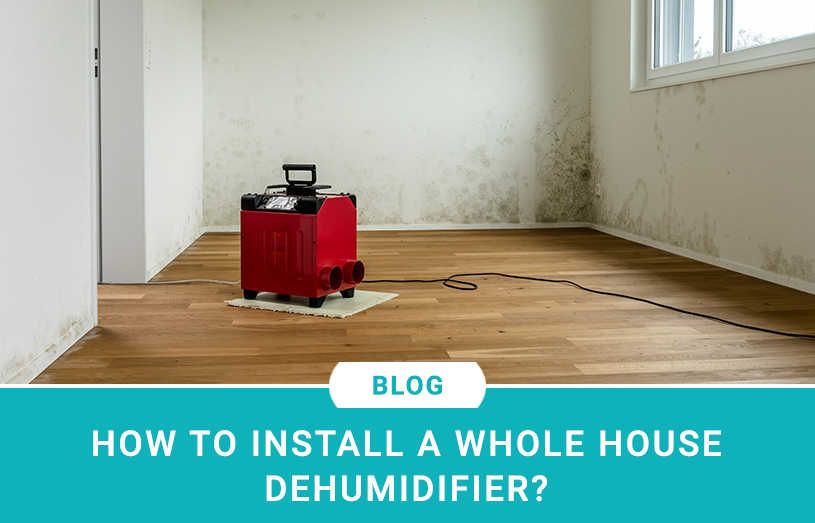Dehumidifiers started to play a big role in our lives when studies about humidity and respiratory health started to pop up. Because each home is faced with certain weather conditions and situations around the world are constantly changing, we had to intervene and start to live more aware.

If you’re looking into buying a dehumidifier, you’ll surely benefit from it, but we’ll talk more in-depth about this topic in another post. Today we’re talking about installation!
Not enough people explain this properly – they give you a buying guide and then… What? How are you supposed to know the installation process? Most of the time, it’s not even that hard. You just need to know how to do it and you’re able to save some cash and not call the plumber to install the gadget.
Today we’ll talk in-depth about the installation process, the tips and the tricks you need to know in order to get minimal issues during the process.
The basic installation process
- The first thing we’ll do is secure the hanging rods if there are any. This obviously depends on the type of system you’re getting, but most house dehumidifiers work in the air and they need to be mounted on a supporting wall.
- Next up, we need to put a dehumidifier in the metal pan. This is another security option and may not be necessary for some models.
- After that, you need to cut a hole somewhere in your hallway. More specifically, a square. This is where you’ll be putting the part called „air grill“ for returning air.
- You now need to attach the return air duct to the dehumidifier. This is the start of our dehumidifier-air grill connection.
- After that, we’re „taping“ the duct along with the framework. We’re getting it out of the way for those who walk around because it’s both expensive to break it and unsafe to trip on it.
- After that, you should go back to the grill and attach the other part of the duct. Keep in mind that you will probably have to cut it to be shorter and fit the hole, but this shouldn’t be a dramatic change. Just don’t cut before you „sketch the length“.
- Now we need to cut the opening where the air supply system meets the air conditioner. Again, be very careful.
- You’ll see that there is another duct that needs to be connected to the air supply and then you plug the other side in the air conditioning system.
- The next connection, and the last one, you need to make is the condensation line. This duct has to go from the dehumidifier to space outdoors.
- Don’t forget to install the actual filter that needs to go into your dehumidifier.
- The last step is mounting the humidistat on the wall. This will help you see when you need to manually change the settings.
The alternative way
Because some people have existing furnaces that can be used with dehumidifiers, they will need to apply alternative processes. Let’s talk through this one as well, since we want you to be covered.
- Shut the house’s power off. Safety comes first in all installation guides.
- Take the dehumidifier to the spot where it will be installed.
- Get the ¾ condensation duct and connect it so it acts as an outside drain connector. This step may require a little bit of creativity, especially if your kitchen is not near doors.
- The next step you need to achieve is attaching the return air duct to the one that is on your furnace. This step should be easy because you can locate the duct near the grill.
What’s the best location for your dehumidifier?
First thing first, they need to be put inside your house. Not on the outside. It should be as close to the return air duct as possible as well. It should not be an obstruction on the way of the filter access panel. The electrical panel should be somewhat close as well, or at least accessible.
Make sure to ensure the temperature stays between 40 and 123 Fahrenheits. This is something people easily forget, but it’s important to keep your mind on it. Another thing, if your supporting structure doesn’t do too good with vibrations of a dehumidifier, you should get vibration absorber.
The most important tips and tricks
We want to give you the best tips and tricks there are out there. Things are better when prevented, especially small issues that take up your money, time and nerves.
- Make sure to measure everything before you cut it.
We said this once already, but you can’t „uncut“ apart and it’s not that cash-friendly to get extra parts just because you’re not sure whether you did the counting right. - Think about vertical and horizontal installations.
If you’re doing vertical installations, you need to support the bottom part of the machine. With horizontal installations, ensure the air supply to the right side. - Think about the ductwork.
If you use up to 25 feet, a 10“ hose is fine when it comes to diameter. With returning air situations, get at least 12“.
Summary
Installing a dehumidifier is not such a big deal, especially if you have worked with similar gadgets before. We have broken down the process for you, but you can also get some extra tips and tricks in the next paragraphs.
Don’t forget to check the product’s installation guide, since those are usually much more specific and they can help you with some questions you may have that are related to the very product. Good luck with your installation!




